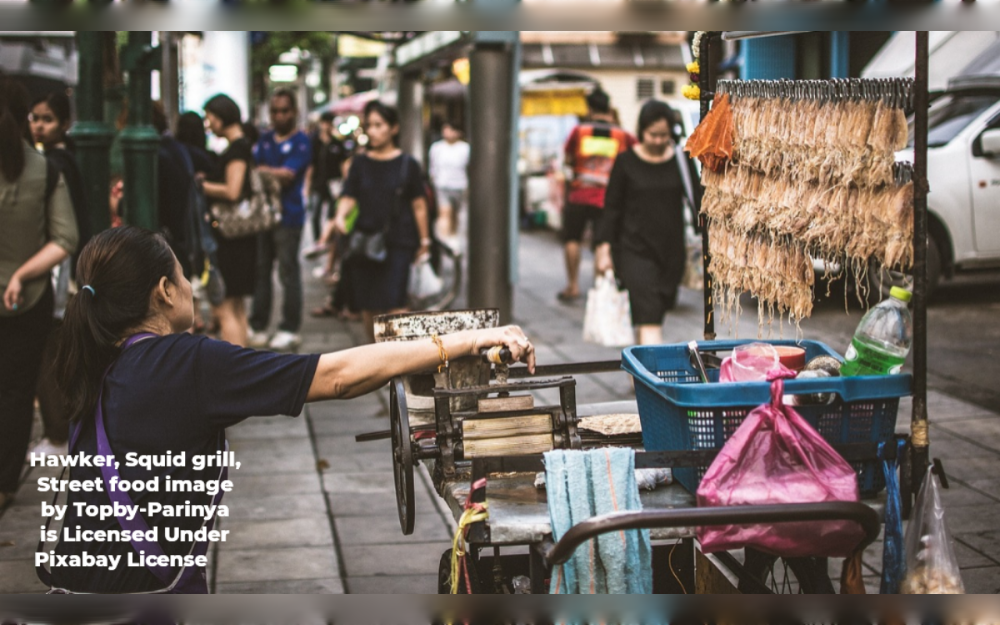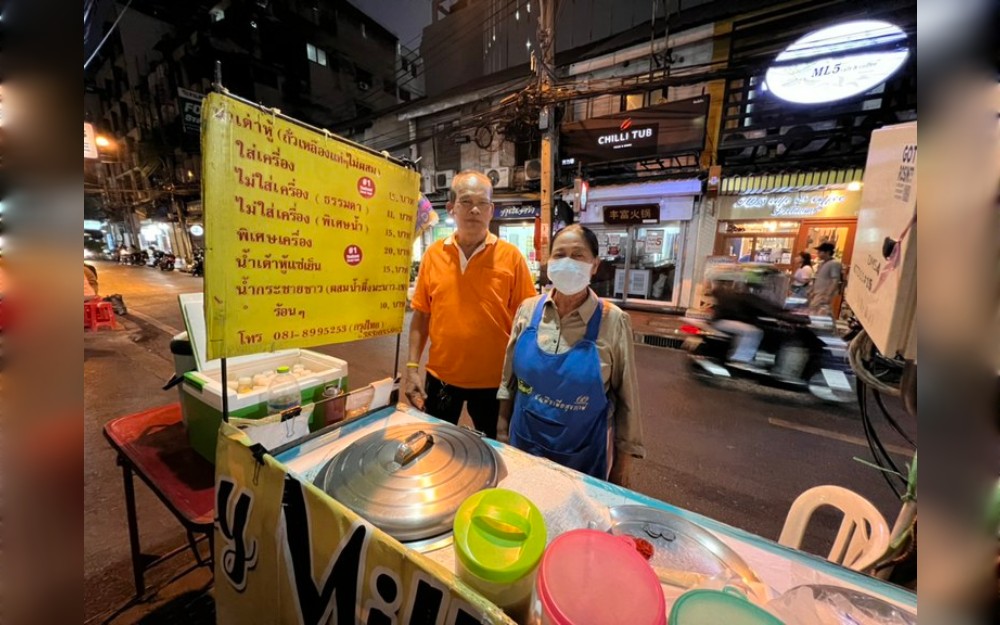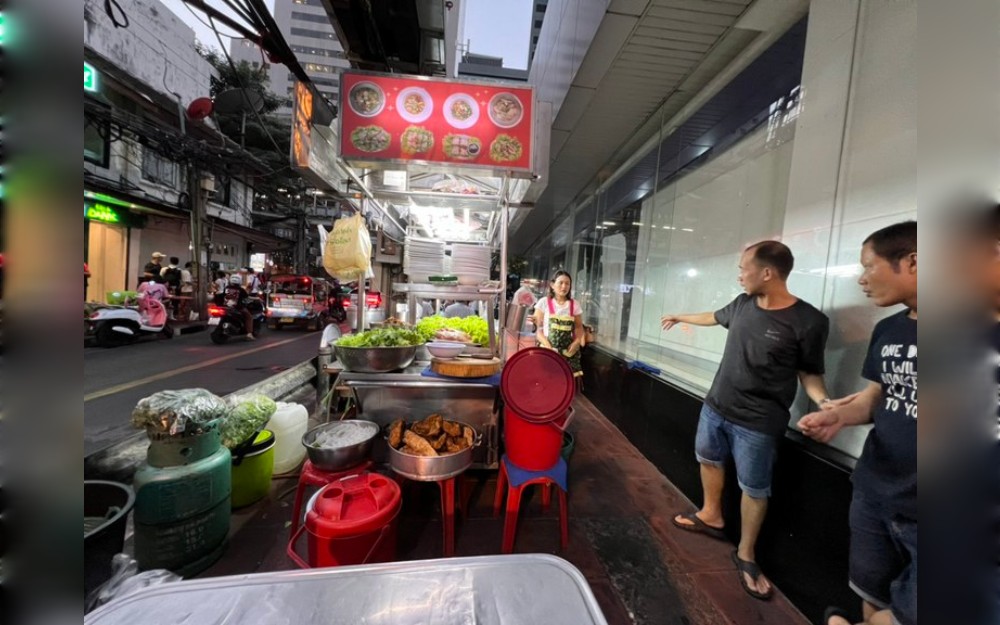Jitsiree Thongnoi,Bangkok

For 28 years, Somsak and Wanna raised three children by selling home-made soy milk from a cart in Silom, Bangkok’s financial district.
About a year ago, the couple began to see their income plummet, they said, because of the city’s forcible relocation of their business.
“Before COVID there were days when we earned up to 2,500 baht (U.S. $69.50), but now some days we earn around 700 baht ($19.46),” said Somsak, 65. “I have attended meetings with the Bangkok officials. They said they want Bangkok to be as beautiful as cities abroad – that is without vendors and stalls.”
As part of Bangkok Gov. Chadchart Sittipunt’s policy to clean up the capital’s sidewalks, Somsak’s soy milk cart is among dozens forced to move from their original locations. The cart used to be on a sidewalk in Silom, where malls and offices are located, but it was moved to a little alley nearby.
“Office workers don’t walk past this way,” Somsak told BenarNews.
Bangkok is slowly pushing through a process to clean up the city’s sidewalks and properly manage street food carts, one of its best-known tourist attractions, to accommodate foot traffic and to offer hygienic street food.
For decades, street food has been an economic lifeline for the city. It offers affordable meals for office workers, day laborers and tourists alike while allowing vendors to earn regular incomes.
But this long-standing street food culture is set to change. Within the capital city of around 15 million people, there has been a growing call for Bangkok to provide a safe environment for walkers on its narrow and congested sidewalks.

After Chadchart visited Fukuoka, a city in Japan, in August 2023, he said that its sidewalks served as a model for his plan to revamp Bangkok’s pavement with its cleanliness and superb public management.
The Bangkok Metropolitan Administration (BMA), the agency Chadchart leads, is conducting a public hearing this month on draft regulations for street food. It covers zoning, the vendors’ screening process and certain technical aspects and rules on food hygiene.
Crowded sidewalks
In Bangkok, many sidewalks are occupied not only by street food vendors, but signboards, bus stops and stations for motorbike taxis, garbage bins and trees. Most Bangkok sidewalks are narrower than two meters (6.5 feet) wide.
A fruit seller on Sukhumvit Road, an artery in central Bangkok, told BenarNews that she rented the front stairs area of a building for her business. This allows her to place the cart on the footpath but she can move it to the steps whenever the need arises.

Stalls like this pose problems for Bangkok resident Manit Intharapim, 56, who has been confined to a wheelchair for more than three decades.
“The Bangkok sidewalks have never been improved. They have been like this for so long that no one sees anything wrong with them,” he said.
“We want good, convenient, clean and safe sidewalks for everybody,” Manit said. “Sidewalks in commercial urban areas are stipulated to be at least 1.5 meters (five feet), wide enough for two people to walk in opposite directions. A ramp or a space on the sidewalk for wheelchair users like me to pass needs to be at least 90 centimeters (36 inches) wide.”
The metropolitan administration is planning to revamp 1,000 km (621 miles) of sidewalks across Bangkok, making them clean, clear and organized by adding more greenery and fixing problems including uneven surfaces, potholes, loose tiles and pools of water.
‘The way Thais behave’
About a year ago, the BMA announced plans to move about 70 stalls in Silom, including Somsak’s, to a nearby hawker center. A brawl between vendors and BMA officials almost turned physical but in the end no one was hurt.
A compromise was reached as Somsak and fellow vendors agreed to move their stalls to the alley where they can still sell on the sidewalk.
In the Silom alley, a nearby pork soup stall sets up its tables and chairs as the eating area on the sidewalk where it gets busier as night approaches. There is no sink, water tab or drainage on the cart.
Bangkok’s “hawker centers” for vendors take inspiration from Singapore, which for decades has been exemplary in the way it manages street food stalls. A Bangkok official said Singapore began moving street food vendors to hawker centers in the 1970s and it took the city-state over a decade to achieve results.
As of 2023, the BMA estimated that there were about 20,000 vendors on the streets of Bangkok. Officials said they had worked to locate about 125 hawkers centers to accommodate around 10,000 vendors.
The city government’s efforts, meanwhile, have led some vendors to raise concerns about potential high rent and bad locations.
A hawker center opened by Chadchart in January sat nearly empty in February. A resident said vendors had to push their carts to the street outside because there were no customers.
“If I move to the hawker center, I have to pay about 1,000 baht ($28) rent per day and nobody walks past that way. It is just the way Thai people behave. They walk past things, if they want to buy them, they buy them,” Somsak said.
“City officials told me to change my job, suggesting I could work as a security guard and my wife could work as a housemaid. At our age? How did they even come up with something like that?”
Chadchart is not the first Bangkok governor to initiate an effort to clean up the city’s sidewalks. Most recently, in 2017, then-Gov. Aswin Kwanmuang announced plans to ban street food in Bangkok except for two tourist magnet areas – the Yaowarat (Chinatown) district, and Khao San Road, the backpackers’ haven in the city’s historic quarter.
In 2022, Chadchart said there were “two sides to the issues including the people’s hardship and the city’s order, although there was no measure to be lenient when it comes to the city’s order.”
Copyright ©2015-2024, BenarNews. Used with the permission of BenarNews.














